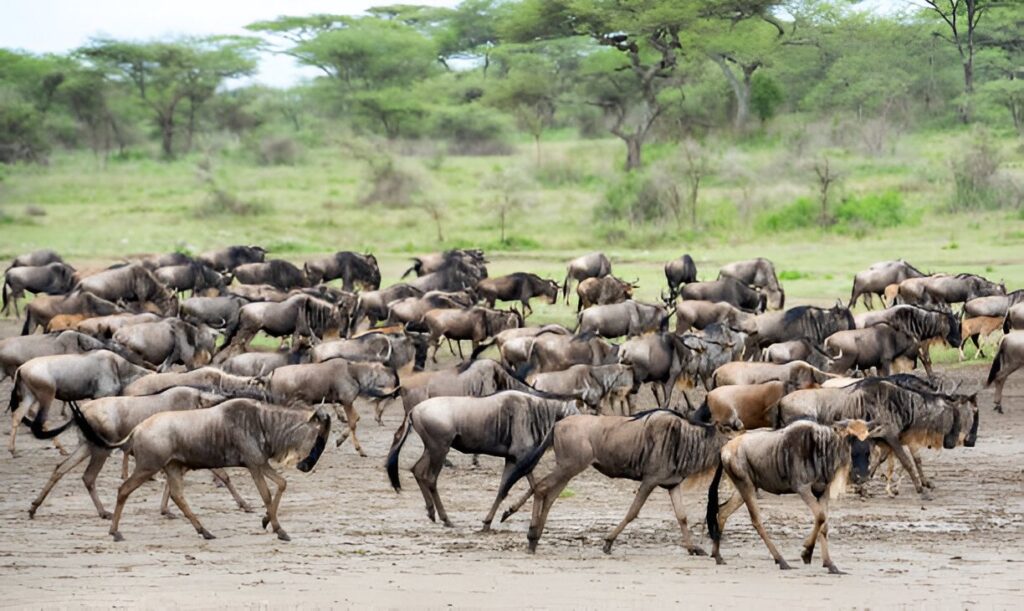The Great Wildebeest Migration
The Great Wildebeest Migration
Introduction
The Great Wildebeest Migration stands as one of nature’s most awe-inspiring phenomena, involving the annual movement of over 1.5 million wildebeest, along with hundreds of thousands of zebras and gazelles. This mass migration takes place primarily between the Serengeti National Park in Tanzania and the Maasai Mara National Reserve in Kenya, covering a distance of approximately 800 kilometers (500 miles) round trip. The migration is intricately linked to seasonal rainfall patterns, with the herds constantly seeking greener pastures and fresh water sources. It is a testament to the instinctual drive for survival in the animal kingdom, where the movement is driven by the availability of resources crucial for sustaining such a massive population.
Each year, the migration follows a cyclical pattern, starting with the calving season in the southern Serengeti from January to February. As the dry season progresses, the herds begin their northward trek from March to June, moving towards the western corridor and eventually gathering momentum towards the northern plains and the Maasai Mara. The climax of the migration occurs from July to October, marked by dramatic river crossings across the Grumeti River in Tanzania and the Mara River in Kenya, where thousands of animals brave crocodile-infested waters in search of better grazing lands. This incredible natural spectacle not only underscores the resilience and adaptability of wildlife but also draws thousands of tourists each year to witness this remarkable display of nature’s grandeur.
Route and Geography
The Great Wildebeest Migration spans across the vast landscapes of Serengeti National Park in Tanzania and Maasai Mara National Reserve in Kenya, encompassing some of East Africa’s most iconic wilderness areas. In Tanzania, the Serengeti National Park serves as the primary stage for the migration, offering expansive plains where the wildebeest graze and give birth during the calving season from January to February. As the dry season progresses, the herds begin their journey northward, passing through the Serengeti’s western corridor towards the Grumeti River. This river crossing, typically occurring between May and July, poses a critical challenge as crocodiles lie in wait for the migrating herds.
Across the border in Kenya, the Maasai Mara National Reserve awaits the arrival of the migrating herds from July onwards. The Mara is renowned for its lush grasslands and the dramatic Mara River crossings, which occur between July and October. These crossings are some of the most dramatic scenes of the migration, where thousands of wildebeest brave the river’s currents and crocodile-infested waters in a bid to reach the greener pastures of the Mara. The convergence of these natural landscapes, characterized by vast plains, winding rivers, and seasonal changes, creates the perfect stage for one of nature’s greatest spectacles, attracting visitors and wildlife enthusiasts from around the globe.
Reasons for Migration
The Great Wildebeest Migration is primarily driven by two key factors: the search for food and water, and predator-prey dynamics.
Firstly, the movement of over 1.5 million wildebeest, along with zebras and gazelles, is intricately tied to the availability of grass and water. In the Serengeti and Maasai Mara ecosystems, rainfall patterns dictate the growth of grass, which serves as the primary food source for these herbivores. As the dry season progresses and grass becomes scarce in one area, the herds instinctively move in search of greener pastures and fresh water sources. This cyclical movement ensures that the herbivores can sustain themselves and their offspring throughout the year, following a path that has been shaped by millennia of adaptation to the East African savannah’s seasonal changes.
Secondly, predator-prey dynamics play a crucial role in influencing the migration patterns. The presence of large carnivores such as lions, cheetahs, and hyenas creates a perpetual cycle of chase and evasion. Predators often concentrate their efforts near river crossings and areas of dense vegetation, where they can ambush weaker or isolated individuals from the migrating herds. This dynamic interaction between herbivores and predators shapes the migration routes, as the herbivores navigate through landscapes that offer both grazing opportunities and potential dangers from predators. Ultimately, the migration represents a complex interplay of ecological factors, illustrating nature’s intricate balance between survival strategies and natural selection in one of the world’s most renowned wildlife spectacles.
Migration Season Phases
Calving Season (January to February)
During January and February, the southern Serengeti becomes the stage for the extraordinary calving season of the Great Wildebeest Migration. Here, over half a million wildebeest gather to give birth in a synchronized spectacle of nature. The vast plains provide nutrient-rich grasses essential for the lactating mothers, ensuring the survival of their young. However, this period also marks a time of heightened vulnerability as predators capitalize on the abundance of young calves. Lions, cheetahs, and hyenas are active hunters, making this phase a critical test of survival for the newborns amidst the lush, albeit perilous, environment.
Migration North (March to June)
From March through June, the massive herds of wildebeest, accompanied by zebras and gazelles, embark on their northward journey. Departing from the southern Serengeti, they traverse through the western corridor, driven by the quest for greener pastures and influenced by seasonal rainfall patterns. The migration northward is a continuous movement characterized by vast columns of animals on the move, grazing as they progress. This phase of the migration plays a crucial role in maintaining the ecological balance of the region, with the grazing patterns contributing to the rejuvenation of vegetation and soil nutrients.
River Crossings (July to October)
The most iconic and dramatic phase of the Great Wildebeest Migration unfolds from July to October when the herds face the daunting river crossings. At the Grumeti River in Tanzania and the Mara River in Kenya, hundreds of thousands of wildebeest gather, hesitating before plunging into the crocodile-infested waters. The crossings are fraught with danger as crocodiles lurk beneath the surface, while lions and other predators await on the banks, ready to seize any opportunity. These spectacles of survival and predation are among the most captivating natural events, drawing tourists and researchers alike to witness nature’s raw intensity. By October, the herds arrive in the Maasai Mara, where they graze and recuperate before the cycle begins anew.
Each phase of the Great Wildebeest Migration not only showcases the resilience and adaptability of these animals but also underscores the intricate ecological dynamics of the Serengeti-Mara ecosystem. From birth and growth to migration and survival, this annual journey is a testament to the enduring rhythms of life in one of Africa’s most iconic landscapes.
Migration Impact on Ecosystem
The Great Wildebeest Migration exerts a significant impact on the ecosystem of the Serengeti-Mara region, influencing both nutrient cycling and predator-prey dynamics. The migration, involving over 1.5 million wildebeests alongside zebras and gazelles, plays a crucial role in shaping the landscape and biodiversity of these African grasslands.
Nutrient Cycle
During their annual journey, wildebeests and other herbivores graze extensively across vast expanses of the Serengeti and Maasai Mara. This grazing behavior not only controls the height of vegetation but also stimulates new growth by pruning plants and dispersing seeds. Additionally, their droppings, rich in nutrients, fertilize the soil, enhancing its fertility. This process enriches the nutrient content of the soil, supporting the growth of a diverse array of plant species and fostering a cycle of growth and renewal in the ecosystem.
Predation Dynamics
The migration also plays a pivotal role in predator-prey interactions within the region. Predators such as lions, cheetahs, leopards, and crocodiles closely follow the migrating herds, taking advantage of opportunities presented during river crossings and the calving season. These events provide a plentiful food source for predators, sustaining their populations and influencing their distribution throughout the ecosystem. Predators not only control the herbivore populations but also target weaker individuals, contributing to the overall health and resilience of the wildebeest and other prey species.
Overall Ecosystem Health
Beyond its direct impacts on nutrient cycling and predator-prey dynamics, the Great Wildebeest Migration plays a vital role in maintaining the overall health and biodiversity of the Serengeti-Mara ecosystem. The interplay between herbivores, predators, and vegetation supports a high level of biodiversity, encompassing a wide range of plant species, mammals, birds, and insects. This biodiversity, in turn, contributes to the resilience of the ecosystem, enabling it to withstand environmental pressures such as droughts or floods. By influencing vegetation growth and nutrient distribution, the migration helps to sustain the ecological balance of the grassland ecosystem, ensuring its long-term health and sustainability.
In conclusion, the Great Wildebeest Migration is not merely a spectacle of nature but a fundamental driver of ecosystem dynamics in the Serengeti-Mara region. Its influence on nutrient cycling, predator-prey relationships, and overall biodiversity underscores its importance in maintaining the ecological health and resilience of this iconic African landscape.

Why Choose Us
Expert Guides
Guides ensure unforgettable, safe, and enriching experiences on every adventure.
Tailor-made Experience
Tailor-made experiences crafted to fulfill your unique desires and preferences.
Unique Bespoke Deals
Unique bespoke deals tailored to your preferences, creating unforgettable safari experiences.
Hassle Free Adventures
Hassle-free adventures: where every moment is an unforgettable journey.

VerifiedChao MA team of professionals that I would recommend WilliamsomAdventures is a very recommendable Safari team, in the pre-consultation and confirmation of details William gave me the biggest feeling of professionalism and reliability. As I was travelling alone with my children on the safari, I was very satisfied with the safety and hassle-free experience throughout the trip, all the matters were just as William had arranged for us before departure, and all our requirements were greatly satisfied. Our guide, Ibra, was very professional on our safari and helped us to maximise our safari with safety in mind, we saw a lot of animals on our journey and he introduced us to many of them to help us understand the land better. Undoubtedly, my children and I were very impressed with this trip in July and I would gladly recommend them to friends who are interested in going Safari in Tanzania.Verifiedjeff C7-Day LeMosho Route I'm thrilled with Williamson Adventures! My brother and I traveled from Canada and were initially quite nervous about trekking Mount Kilimanjaro. However, upon arriving in Moshi, all our nerves vanished. We were warmly welcomed at the hotel by William and one of our guides, who were incredibly friendly. The rest of the trip was fantastic! The guides, porters, and cooks were all amazing, and the food was delicious. The support and encouragement we received throughout exceeded our expectations. Planning the trip required some coordination, but William was always quick to respond and incredibly helpful. For example, he seamlessly arranged our pick-up from Nairobi to Moshi. He also organized an extra night at the hotel in Moshi and an airport shuttle, even though he didn't have to. This company truly goes above and beyond to make the experience unforgettable. We highly, highly recommend Williamson Adventures! Thanks to William, our guides Kevin and Yoeseff, and our amazing porters—the real superheroes!VerifiedXinyue QGreat Safari Experience Experienced guide, saw all of the great five. Communication is fast with quick response. The itinerary arrangement is reasonable and interesting. Despite some misunderstanding in the beginning, William was able to rearrange accommodation within short period of time. Helped to celebrate birthday of one friend during the trip, very unforgettable experience!!VerifiedLeon CLucky safari We came across Williamson Adventure by accident, and we also chose a few ground handlers to compare, and Williamson was the one with the fastest feedback and the best value for money in terms of combined quotes. Our team of 10 people unanimously gave them five stars, they provide the best service. The owner of Williamson was patient and meticulous in communicating with us beforehand and tried his best to meet our every request, and he also solved the problems we encountered during the safari, and even went to the airport to see us off before we finally left Arusha. We are very satisfied with Williamson's sincerity, and would like to recommend it to every friend who is interested in safari in Tanzania, it's really great and very thoughtful!VerifiedNavigate14938214079一次精美的safari旅行 Williamson Adventures是一家特别棒的地接社,行程安排超过预期,在交流阶段针对各种细节都回复的特别耐心,酒店也很早就预定下来,而且还贴心为我们安排了从桑岛机场到酒店的接机服务,非常满意,超预期VerifiedAshleyOutstanding experience with Williamson Adventures I would say I couldn't be more impressed with their service provided by Williamson Adventures! William were incredibly helpful, he always replied to my messages in a quick and efficient way. The logistics of the trip were flawlessly managed. Transfers, guides were all arranged seamlessly, allowing me to relax and immerse myself in the safari adventure. The guide has experience of more than 10 year, was really a pro—well-informed, friendly, and passionate about sharing their knowledge of those animals and landscapes. And we managed to see Big Five! Overall, Williamson Adventures exceeded my expectations in every way. Their professionalism, attention to detail, and genuine care for their clients’ experiences make them a great choice for anyone planning a trip to Tanzania. I really appreciate that and will definitely come back again! xVerifiedWander09596438110难忘的非洲之行 第一次去非洲旅游,通过safarigo与多家地接社取得了邮件联系,William是其中回复最迅速且沟通最顺畅的,添加微信后对行程的安排和细节都根据我们的要求一一修改核对,他替我们安排的最后一晚住宿甚至能在房间阳台看见斑马和水羚;因为国际航班晚点导致在坦桑尼亚国内转机时间不足的问题能及时帮忙与航司沟通解决,后续发生了一些不愉快也妥善处理了;向导Godlove车技杠杠的,我们车况OK工具齐全,路上碰到其他地接社的车辆故障他都会出手相助,safari途中多次近距离看到狮子也多亏有他。此外想提醒各位同胞,坦桑尼亚的中国游客相对较少,中文导游水平良莠不齐,如果需要地接社提供相关服务,建议通过即时通讯软件提前确认导游的口语水平,以免出现与预期大相径庭的情况。总的来说,这是一次非常难忘和美妙的非洲之行,希望有机会能再来坦桑尼亚。Verifiedisrael cProfessional and reliable service. 100% recommended the company Williamson Adventures. It was a pleasure to have booked my trip with this company. Very good communication from the beginning. They helped me with the 5-day itinerary in Tanzania, visiting the most important parks such as Tarangire, Lake Manyara, Serengeti and Ngorongoro. The guide we had was very punctual and also very professional at each point we visited. The Lodges that were booked were of good quality and generally very professional service. 100% recommendable. Thanks for everything William!!VerifiedRafael MBest safari in Ngorongoro, Serengeti, Tarangire and Lake Manyara The best safari agency in Tanzania. The best price on a 5-day safari checked with 8 other agencies !!! Very good driver and guide.VerifiedLCF201309077-Day Migration Safari with Williamson: A Once-in-a-Lifetime Experience! My friend and I had a 7-day migration safari (River Crossing) with Williamson Adventures exceeded our expectations. The captivating sights of wildebeest herds were absolutely breathtaking, a true testament to the wonders of nature. Our knowledgeable guide Raymond made the experience even more remarkable with his deep understanding of the wildlife and their behaviors. The seamless combination of the safari with a day trip to Materuni Waterfall and Coffee Tour added a perfect touch of cultural immersion. The lush greenery and the thundering waterfall were a sight to behold, and the coffee tour was enlightening. Williamson's team orchestrated a flawless journey, ensuring comfort and safety throughout. This safari was a life-changing experience, and I'm incredibly grateful to William and his team for making it so exceptional.Showing our latest reviews
The Great Wildebeest Migration faq's
How many wildebeest in the great migration?
The Great Wildebeest Migration involves over 1.5 million wildebeest, making it one of the largest land migrations on the planet. This massive movement also includes hundreds of thousands of zebras and gazelles, creating a spectacular natural phenomenon across the Serengeti in Tanzania and the Maasai Mara in Kenya.
When is the great wildebeest migration?
where is the great wildebeest migration?
Why is the Great Wildebeest Migration significant?
What should I pack for a migration safari?
Essentials include lightweight clothing in neutral colors, sturdy walking shoes, a wide-brimmed hat, sunscreen, binoculars, and a camera with extra batteries and memory cards for capturing wildlife sightings.
How it works
- Describe your dream adventure
- Expert will help curate your experience
- Confirm & start packing for the adventure

Let's plan your dream Safari!
Enquire now and Our Experts will get back to you within 24 hours




